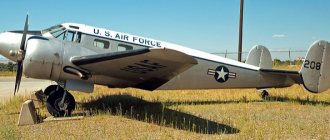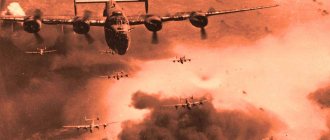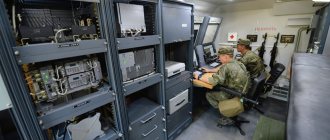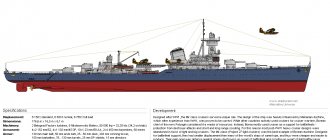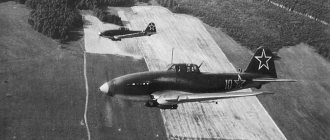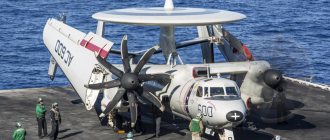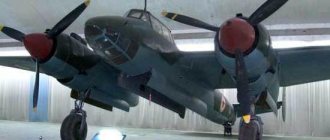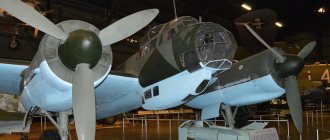R-6 (ANT-7) is a multi-role Soviet aircraft that had the following mission options: reconnaissance aircraft, bomber, torpedo bomber, three-seat fighter.
Story
In the mid-20s, a theory became popular about the need to deploy long-range fighters in military forces to penetrate deep behind enemy lines.
By slightly reworking the TB-1 design and equipping it with BMW-IV engines, it was possible to reduce the size and weight of the aircraft. The aircraft's speed was approximately the same as that of single-engine biplanes of the time. The first prototype was built in September 1929, and testing began only in May 1930 after modifications to the aircraft. State flight tests began in October 1931. Having successfully completed them, we began serial production of the model.
The first batch was produced in Moscow at plant No. 22. Then, from 1932, serial production was moved to Taganrog to plant No. 31. Since 1934, serial production was resumed in Moscow under the designation KR-6. Production continued until 1935, and over the entire period approximately 400 P-6 aircraft were built in various versions.
History of the creation of R-6 (ANT-7)
By the beginning of the 1930s, a very unusual situation had developed in the USSR - there were already enough TB-3 heavy bombers, but the tactics for using large formations of these machines had not yet been created.
It was decided to “cheat” - to take over the organization of combat formations from the navy. In the fleet, the basis of the squadron was made up of battleships - the main striking force, but the tasks of reconnaissance, covering and distracting the enemy were carried out by cruisers. Accordingly, the already existing TB-3s became “air battleships”, and the “air cruiser” had yet to be created. These aircraft became ANT-7 or R-6 (reconnaissance-6).
The new aircraft was created at the A.N. Tupolev Design Bureau in 1929. It was developed on the basis of the aerodynamic design and design of the TB-1 bomber, but had smaller dimensions.
"BOING RC-135V/W RIVET JOINT" - a unique radar reconnaissance aircraft
Electronic reconnaissance aircraft (USA)
The RC-135V/W’s “cheeks” (radomes) contain electronic radar systems
Currently in the USA, the RC-135V/W is considered the main means of detecting various sources of radio emission. It is one member of a family of reconnaissance aircraft collectively known as the RC-135. It was created in 1973 from the RC-135C photo and electronic reconnaissance vehicle. It differed from its predecessor in its special elongated nose, filled with reconnaissance equipment, as well as many different antennas on the wing and under the bottom.
The scout was given the name “Rivet Joint”, which means “rivet joint”. The crew was the largest in the history of reconnaissance aviation: 3 electronic warfare operators; from 12 to 16 people conducting observation of the enemy; 7 technical operators performing radio-electronic emissions analysis; a specialist compiling maps of radio-electronic emissions, with 2 assistants; 2 operators responsible for detecting non-standard or unidentified signals. In addition, there was an operator to transmit data to other aircraft and 2 people involved in maintenance.
The scallops on the top of the fuselage are radio navigation and radio communication antennas
Six Rivet Joints took part in Operation Desert Storm. Currently, the US Air Force has 14 vehicles of the “V/W” modification; 2 “U” modification aircraft with completely secret equipment; 2 modifications “S”, collecting information about ongoing tests of ballistic missiles. All of them are equipped with the latest American intelligence technology.
The pylons with rods mounted on the top of the wings are antennas for the high-frequency communications system
The RC-135V/W's nose cone houses a powerful radar
Design and purpose of the R-6 (ANT-7) aircraft
Structurally, the R-6 (ANT-7) is a twin-engine cantilever monoplane with a low wing. The design of the aircraft was all-metal. The sheathing was made of corrugated sheets 0.3-0.8 mm thick with a corrugation pitch of 32 mm.
According to the designers, the P-6, as a long-range escort fighter, was supposed to escort bombers in combat formations. At the same time, the “cruiser” itself could only carry small bombs, but there were three gunners and five machine guns on board.
The second important task assigned to the R-6 was long-range reconnaissance. It was believed that he could independently operate behind enemy lines. The idea of creating such an aircraft was popular in the 1920-30s, but in practice the concept could not be tested - the R-6 was not used in combat for its intended purpose.
The prototype ANT-7 with BMW-VI engines (730 hp) was ready on September 11, 1929. Testing began in May 1930. Based on their results, the vehicle was modified, and the R-6 (ANT-7) with M-17 engines was put into mass production as an air combat, long-range reconnaissance and bomber escort aircraft.
Production of the P-6 at Moscow Aviation Plant No. 22 was discontinued in 1932 after the assembly of the 45th copy. Unused components and assemblies were transferred to plant No. 31, where float planes were produced.
R-6 (ANT-7) before takeoff. It is relatively easy to distinguish from TB-3 and TB-1 by its simplified appearance
Forgotten cruiser
Home » Books on aviation history » Forgotten cruiser
Books on the history of aviation Little-known and unrealized projects of aircraft and other flying equipment
Comrade Sukhov 02/22/2020 1355
19
in Favoritesin Favoritesfrom Favorites 12
The birth of the “air cruiser” class of combat aircraft dates back to the end of the First World War, when, with the advent of heavy bombers, it was necessary to ensure their security and protection from attacks by enemy fighters along the entire flight route of the bombers. To do this, it was necessary to create intermediate-class aircraft, called “air cruisers,” with speeds close to those of single-seat fighters, a large range and powerful small arms and cannon weapons. In addition to the function of defending bombers, such aircraft were assigned the tasks of reconnaissance, conducting battles with enemy bombers, and conducting bombing strikes.
In the USSR, the immediate impetus for the creation of “air cruisers” was the creation of TB-1 heavy bombers in the mid-20s. In October 1926, the design bureau, on its own initiative, at the suggestion of A. N. Tupolev, began designing an all-metal twin-engine aircraft ANT-7, which was designed for its purpose as an “air cruiser”. The new aircraft was designed for two engines with a power of 500-600 hp. and was actually a smaller version of the ANT-4 (TB-1). The UVVS, having familiarized itself with the work performed, recognized them as promising and soon issued TsAGI preliminary technical specifications for the aircraft. In the design bureau, work on ANT-7 was distributed as follows:
V. M. Petlyakov was responsible for the wings and landing gear, N. I. Petrov - for the fuselage, N. S. Nekrasov - for the tail, A. A. Arkhangelsky - for control, E. I. Pogossky and I. I. Pogossky - for the power plant.
In design and appearance, this all-metal monoplane with two M-17 engines resembled the TB-1 bomber, but differed from it in its smaller size. After some modifications and changes in the tail design, the aircraft was lightened by 80 kg. The empty weight became 3700 kg, the take-off weight remained the same - 5400. During testing, a maximum speed of 240 km/h was achieved. In addition to the wheeled one, a float version of the aircraft, called Kr-6, was also built. And although its weight was 700 kg more, the flight performance data changed little.
The P-6 crew consisted of four people: the main pilot, the second pilot (who is also the navigator and nose gunner), the gunner-radio operator in the rear turret and the gunner in the ventral turret. The central cockpit of the main pilot was shifted to the left side of the fuselage and was located in the plane of the leading edge of the wing. The fuselage had a narrow corridor between the nose and tail cabins.
The aircraft was controlled in two ways: the aircraft and engine control posts were installed in the main pilot's cockpit and in the second pilot's bow cockpit, and the second pilot's control was turned off when firing from the bow machine guns.
By August 1927, the aircraft was put into pilot production. The order for the series is received by plant No. 22. The issue with the engines, which were of the same type as the TB-1 (BMW VI - M-17), is finally being resolved. By August 26, 1929, the first ANT-7 (VVS designation R.-6) was completed. At the beginning of September, the ANT-7 was transported to the airfield, and in the same month, factory tests began, which were conducted by test pilot M. M. Gromov. Testing and development continued until March 1930. On March 11, the aircraft was transferred to state tests, which lasted until mid-October 1930, based on the results of which the aircraft was recommended for production and service as a “long-range reconnaissance aircraft” and “escort aircraft” (R- 6 and KR-6).
In the “air cruiser” version under the designation Kr-6, the aircraft was a three-seater without a retractable ventral turret and a four-seater. On the R-6 and Kr-6 aircraft, as well as on the TB-1, there was a stabilizer controlled in flight and an adjustable keel on the ground.
Armament - 3 pairs of machine guns and 500 kg of bombs on an external sling. The R-6 bomber armament provided external suspension under the fuselage and wing center section of six AF-32 high-explosive aircraft bombs with a total weight of 192 kg. The on-board equipment of the R-6 included a Potte-type photo installation and a 13SK radio installation.
The construction of the first experimental aircraft in the R-6 long-range reconnaissance version was completed a year after the prototype was approved, and on September 11, 1929, pilot M. M. Gromov performed its first flight. Due to vibrations of the power plants and empennage revealed in flight, as well as a number of other less significant defects, the tests of the prototype aircraft were delayed, but, nevertheless, it was recognized that the R-6 was suitable for its purpose.
In the version of the air combat aircraft with a flight weight of 5121 kg, a maximum speed of 244 km/h at an altitude of 3000 m was obtained on an experimental aircraft with imported BMW-VI engines. The maximum speed obtained on the experimental R-6 aircraft was only slightly less than the flight speed of single-seat serial fighters that time I-3 and I-4.
According to the Air Force Research Institute, the serial R-6 aircraft was superior in a number of its flight characteristics to foreign aircraft of a similar type, in particular, the five-seat twin-engine escort fighter Bleriot 127.
The standard for the series at plant No. 22 was the modified prototype aircraft. On October 5, 1931, the first production aircraft R-6 with two M-17 engines was transferred to the Air Force Research Institute for state testing. After eliminating all the shortcomings identified during testing of the lead aircraft, full-scale production of the aircraft began. Beginning in 1932, at plant No. 31 in Taganrog, a series of float version of the P-6, the MP-6 aircraft, was mastered. Since 1936, the R-6 aircraft has been built at the new plant No. 126 in Komsomolsk-on-Amur.
The main drawback of the first production R-6 aircraft was the vibration of the empennage during spirals and gliding, which was not eliminated during testing. It was found that the cause of vibration of the tail was buffeting.
To identify the cause of wing stall and eliminate it, large-scale flight studies of three P-6 aircraft were carried out in the summer of 1932. On one of them, the entire root surface of the wing was cleared of superstructures that could disturb the flow around the wing. On another aircraft, a slat was installed on the section of the wing between the side of the fuselage and the engine nacelle, and on the third, a profiled flap was installed, and there was a gap between the trailing edge of the wing and the upper surface of the flap that reached the aileron. The greatest effect associated with the complete elimination of vibrations on all flight modes, was obtained on an airplane with a flap.
Based on the results of state tests of these aircraft without a retractable ventral turret, carried out in December 1932, it was concluded that in terms of its flight characteristics the aircraft could be used as an “air cruiser”, long-range reconnaissance aircraft and bomber. In addition, military experts suggested that TsAGI study the possibility of using the MP-6 as a low-altitude torpedo bomber, dropping torpedoes of the 1912 and 1927 models. from a height of 5-20 m at a speed of 130 km/h.
Comprehensive development of torpedo-throwing techniques on TB-1P and MR-6 aircraft, successful military tests of the first Soviet torpedo bomber aircraft contributed to the development in the mid-30s of more advanced tactical and technical requirements for such aircraft and the creation of specialized torpedo bombers T-1 and DB-Z , and then the organization of mine-torpedo bombing aircraft on the eve of the Great Patriotic War.
Since 1935, these machines, called MP-6 and PS-7, were also used in the Civil Air Fleet. One of the planes had a common closed cabin for 9 people. On the civilian version of the ANT-7 aircraft, on May 5, 1937, pilot P. Golovin was the first in our country to fly over the North Pole to clarify the possibility of landing on the “top” of the Earth for the scientific expedition of I. D. Papanin.
One of the P-6 aircraft with tail number N-166 became the first Soviet aircraft to fly over the North Pole. On it, the crew of pilot P. G. Golovin on May 5, 1937, made a non-stop reconnaissance flight from Rudolf Island (Franz Josef Land) to the North Pole area and back in order to clarify the meteorological and ice conditions, determine the possibility of landing heavy ANT-ships on ice 6 “Aviaarktika” for the organization of the drifting station “North Pole-1”, led by I. D. Papanin.
Throughout the Great Patriotic War, the remaining P-6 aircraft in service were used to transport flight personnel when relocating airfields, supplying Air Force units with ammunition, spare parts, fuel, for communication between headquarters and units, and for transporting medicine and the wounded.
The experience of operating the R-6 and Kr-6 in Air Force units determined two main directions for the development of a combat aircraft of this type: the creation of heavy multi-role fighters and high-speed medium bombers.
Both of these areas developed until the beginning of the Great Patriotic War, either in the form of specialized aircraft (MI-3 fighters, DIP and SB ), or based on the design of one aircraft ( DI-8 based on the SB bomber).
Flight tactical data:
| Crew, people | 4 |
| Wingspan, m | 23,2 |
| Length, m | 15,06 |
| Wing area, sq.m | 80 |
| Empty aircraft weight, kg | 3856 |
| Normal take-off weight, kg | 6472 |
| Maximum speed, km/h | 230 |
| Cruising speed, km/h | 205 |
| Practical range, km | 800 |
| Maximum rate of climb, m/min | 165 |
| Practical ceiling, m | 5620 |
Based on the main serial modifications of the aircraft, there were several variants of the ANT-7, both implemented and those remaining only in projects:
- PS-7 2M-17 and MP-6 2M-17 , land and float versions were transferred, starting in 1936, from the Air Force to the Civil Air Fleet, and were used for cargo and passenger transportation;
- R-6 cannon , at the end of 1930 the option of installing a 37-mm cannon on the aircraft was considered;
- R-6 2M-34 , in 1931 the design bureau carried out calculations for modifying the aircraft for two M-34 engines, the project was not implemented;
- R-6 with additional fuel tanks , in 1932 work was carried out to install additional fuel tanks in the wing of the aircraft, it was not introduced into the series;
- R-6 with radiators in the wing , in 1935 factory tests of the serial R-6 with wing radiators were carried out, but were not introduced into the series;
- MR-6T , an experienced torpedo bomber, was tested in 1934, and the torpedo launching method was tested on it;
- ANT-7 passenger - the first prototype, converted into a seven-seat passenger aircraft with an increased level of comfort;
- R-6 Paravan , a serial R-6 retrofitted with a system for breaking through balloon barriers, was tested in 1937 -1939.
The R-6 aircraft and its modifications were in the first line of the Red Army Air Force until the second half of the 30s. During the Great Patriotic War, the R-6 was widely used for reconnaissance, communication between headquarters, supplying partisan bases and regular army formations operating behind enemy lines with ammunition, spare parts, and fuel. The vehicle towed gliders, landed at partisan “airfields”, taking out the wounded and glider pilots (the gliders were destroyed).
Aircraft of the ANT-7 type were actively used in almost all expeditions conducted in the 30s in the northern and Arctic regions:
- participation of the ANT-7 (N-166) aircraft in the expedition to create the first drifting station SP-1;
- rescuing people from ships drifting in the Laptev Sea at the beginning of 1938;
- in 1939, a PS-7 aircraft made an ultra-long flight from Moscow to Nagaev Bay, covering 9,222 km in just 9 days.
In total, before production ceased in 1936, 407 ANT-7 aircraft of all modifications were produced (R-6 2M-17, MR-6 2M-17, KR-6 2M-17, KR-6A 2M-17).
In Kiev, in the training hangar of the National Aviation University (NAU), you can see the world's only example of the ANT-7 aircraft (PS-7, MP-6), which is a civilian version of the R-6 reconnaissance aircraft, created under the leadership of A.N. Tupolev in 1931. The aircraft was restored from parts of three crashed ANT-7s, which were found in the 1980s. in remote areas of the USSR and delivered to Kyiv.
Modifications of the R-6 (ANT-7) aircraft
In July 1933, a passenger version (“limousine”) of the R-6 was produced in one copy with a closed cabin, which was a low superstructure to the fuselage, with glazing, an entrance door on the starboard side and a luggage compartment. The cabin was designed to accommodate 7 passengers. The aircraft showed good flight performance and was transferred for operation to the flight squad of the Aviation Industry Administration. On September 5, 1933, the plane crashed while flying from Moscow to Crimea.
In 1932-34, a float version was mass-produced under the designation MP-6 (marine reconnaissance aircraft - the sixth). The R-6 reconnaissance aircraft was equipped with "Zh" type floats. Compared to the float-powered TB-1, the controllability of the new aircraft was worse, especially during landing. In 1934, serial production of the MP-6 at plant No. 31 in Taganrog was discontinued.
Under the designation KR-6 (“Cruiser”), the aircraft continued to be produced until 1935 at the Moscow Aviation Plant. A number of changes were made to the design: landing flaps were equipped, the rubber damping of the landing gear was replaced with oil-air, brake wheels were installed, fairings were introduced between the wing and the fuselage, and the retractable ventral turret was eliminated.
History of operations[edit]
R-6 in the Soviet Air Force.
.
The first production aircraft rolled off the production line, GAZ-22 (GAZ - State
Aviation Plant) in November 1931, a year after production began. A further 410 aircraft were produced over the next three years: 385 by GAZ-22 in Moscow (one of them the R-6 Limousine), five by GAZ-31 in Taganrog (seaplanes designated KR-6P) and another 20 by GAZ. -12 in Komsomolsk-on-Amur.
The aircraft's standard crew consisted of a pilot, gunner and observer, and the aircraft was capable of carrying 113.4 kg (250 lb) of bombs up to 965.6 km (600 mi). Some were built with floats like the MP-6
(also known as
KR-6P
) for maritime patrol.
Another variant was the KR-6 (KR - Kreiser Razveyedchik
- cruising reconnaissance aircraft), which had two PV-2 machine guns and a second gunner, who was later transferred to training duties.
By 1935 the R-6 had become obsolete and some were transferred to Aeroflot and Avia Arktika, which used them to transport passengers and cargo in Siberia until the Great Patriotic War, designated PS-7-2M17
("2M17" showed that the Aircraft was equipped with two Mikulin M-17s), or as
MP-6-2M17
if floats were attached.
Characteristics of R-6 (ANT-7)
A country:USSRType:Multi-role aircraftYear of issue:1929Crew:4 peopleEngine:2 x M-17F 715 hp eachMaximum speed:230 km/hPractical ceiling:5620 mRange of flight:800 kmEmpty weight:No informationMaximum take-off weight:6472 kgWingspan:23.2 mLength:15.06 mHeight:No informationWing area:No informationWeapons:5 pcs x 7.62 mm DA-5 machine gun + 200 kg bombs
"NORTHROP RF-5E TIGER AI" - long-nosed reconnaissance aircraft
Tactical strike reconnaissance (USA)
The RF-5E differs from the F-5E in its nose section - it is 20 cm longer and has a larger volume for installing reconnaissance equipment
The RF-5E "Tiger Eye" aircraft was developed on the basis of the F-5 fighter, which had the nickname "Tiger" - "tiger". The appearance of the reconnaissance aircraft differs only in its elongated nose, filled with reconnaissance equipment and having an extension in the form of a needle, which serves to refuel the vehicle in the air.
Modern navigation and communication means do not require special attention and allow the pilot to concentrate entirely on reconnaissance tasks.
The world saw this aircraft in 1978 at the Le Bourget air show. Its first flight took place on January 29, 1979. Received the name “tiger eye” in memory of a fellow fighter, it was distributed mainly to the countries of the East: to Malaysia, Saudi Arabia, Taiwan and South Korea.
In terms of armament, the RF-5E is inferior to only a fighter: it has cannons, guided missiles, bombs, and napalm tanks.
The RF-5E, like the F-5E, is easy to fly and has excellent maneuverability.
Since the RF-5E had to “hang” in the air for a long time, performing reconnaissance, an additional fuel tank with a capacity of 1041 liters was often suspended under the fuselage
